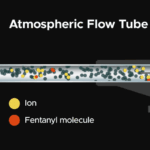2025-06-24 ミシガン大学
 Light conducts around the edge of a simulated topological insulator, shown at the bottom of image. The topological insulator is made from a layer of a 2-D material resting atop a photonic crystal. The red and blue insets illustrate how the light wave twists differently in two example isolated bands (selected from the band structures shown in the right panels) as it moves through the bulk crystal, giving rise to distinct curvature distributions and opposite nonzero Chern numbers. Image credit: X. Xie, K. Sun, H. Deng, Phys. Rev. X. 2025. DOI:10.1103/PhysRevX.15.021061, CC 4.0 license
Light conducts around the edge of a simulated topological insulator, shown at the bottom of image. The topological insulator is made from a layer of a 2-D material resting atop a photonic crystal. The red and blue insets illustrate how the light wave twists differently in two example isolated bands (selected from the band structures shown in the right panels) as it moves through the bulk crystal, giving rise to distinct curvature distributions and opposite nonzero Chern numbers. Image credit: X. Xie, K. Sun, H. Deng, Phys. Rev. X. 2025. DOI:10.1103/PhysRevX.15.021061, CC 4.0 license
<関連情報>
- https://news.umich.edu/a-more-versatile-and-powerful-foundation-for-future-photonic-technologies/
- https://journals.aps.org/prx/abstract/10.1103/PhysRevX.15.021061
ディラックコーンを超える2次元フォトニック結晶におけるポラリトンカーンバンド Polariton Chern Bands in 2D Photonic Crystals beyond Dirac Cones
Xin Xie, Kai Sun, and Hui Deng
Physical Review X Published: 20 May, 2025
DOI: https://doi.org/10.1103/PhysRevX.15.021061
Abstract
Polaritons, formed by strong light-matter interactions, open new avenues for studying topological phases, where the spatial and time symmetries can be controlled via the light and matter components, respectively. However, most research on topological polaritons has been confined to hexagonal photonic lattices featuring Dirac cones at large wave numbers. This restricts key topological properties and device performance, including sub-meV gap sizes that hinder further experimental investigations and future applications of polariton Chern insulator systems. In this study, we move beyond the traditional Dirac cone framework and introduce two alternative band structures in photonic crystals (PhCs) as promising platforms for realizing polariton Chern bands: bands with symmetry-protected bound states in the continuum and bands with symmetry-protected degeneracies at the Γ points. These band structures are prevalent in various PhC lattices and have features crucial for experimental studies. We show examples of higher Chern number bands, more uniform Berry curvature distributions, and experimentally feasible systems capable of achieving topological gap greater than 10 meV. Our findings show the broad applicability of polariton Chern bands in 2D PhCs and provide design principles for enhancing the functionality and performance of topological photonic devices, opening up exciting possibilities for better understanding and using topological physics.



